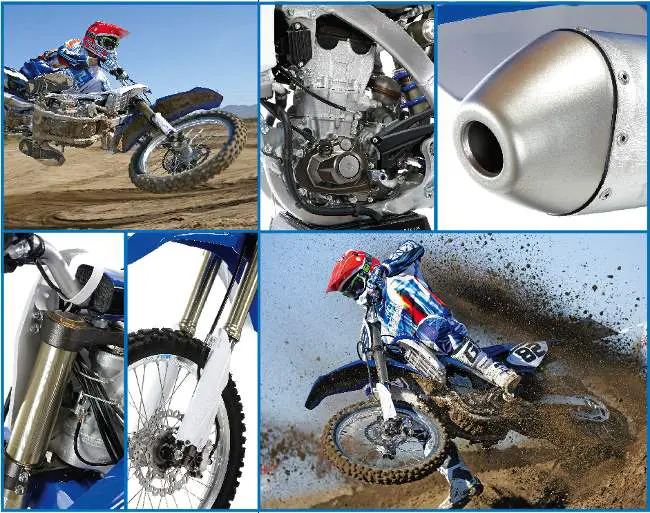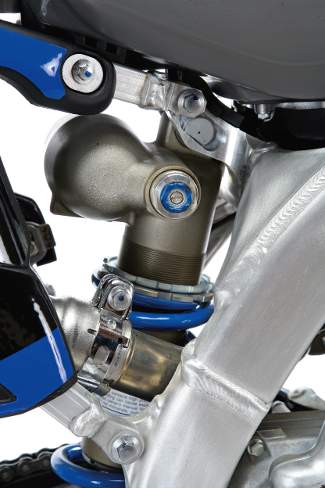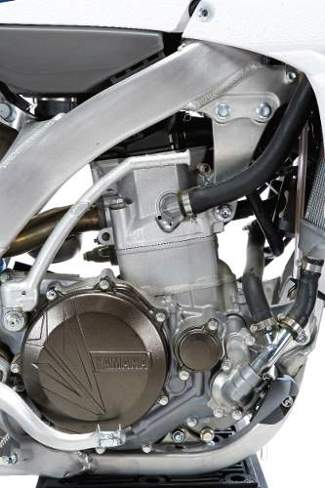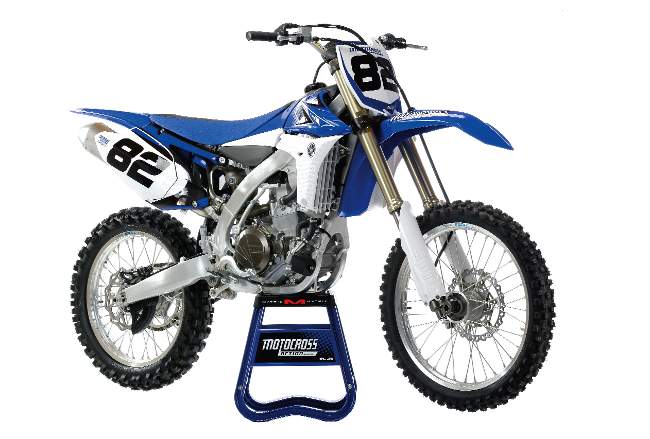2011 YAMAHA YZ450F MOTOCROSS TEST: THE MOST REVOLUTIONARY MOTOCROSS BIKE ON THE SHOWROOM FLOOR

Q: FIRST AND FOREMOST, IS THE 2011 YZ450F BETTER THAN THE 2010 YZ450F?
A: Nope. Oh, don’t get us wrong, we love that the new clutch actuation arm has a slightly heavier pull with less free play whether hot or cold. But in the grand scheme of things, it isn’t much to get excited about.
Q: WHAT ARE THE MAJOR CHANGES THAT YAMAHA MADE TO THE 2011 YZ450F?
A: The clutch actuation arm and the white plastic. That’s the complete list.
Q: IS THE 2011 YZ450F FASTER THAN THE 2010 YZ450F?
A: The fuel-injected, downdraft, four-valve, 2011 YZ450F engine is identical to the fuel-injected, downdraft, four-valve, 2010 YZ450F engine. It is no faster and no slower.
Q: HOW WOULD WE DESCRIBE THE 2011 YZ450F’S POWERBAND?
A: This is your basic by-the-playbook fuel-injected motocross powerband. It’s snappy, quick and responsive off the bottom. It doesn’t hesitate once the throttle is moved and accelerates with a jolt. It pulls into the midrange with lots of steam, but then flattens out after 8000 rpm. It is, for lack of a better word, a very “typical” fuel-injected 450. How so? In the beginning of fuel injection, everyone who rode a fuel-injected bike came back from his first ride gushing about the immediate throttle response, the increase in low-end power and the jolt off the bottom. No one raved about top-end power, because none of the first-generation EFI bikes had any top-end. They were quick, abrupt and violent from low-to-mid and flat as a pancake from mid-to-top.
Now, several years into the fuel-injection foofaraw, the idea that a bike should hit so hard, jolt the rider with a bolt of power and then sign off early has become archaic. EFI’s throttle response was a big talking point a few years ago, but is now a big negative. In response, the engineers of the 2011 Kawasakis, Suzukis and Hondas have all tamped down their low-end hit, lessened the throttle response off idle and tried to make their fuel-injected bikes run like?dare we say it?carbureted bikes.
If you liked the hard hit and crisp low-end action of the first generation of fuel-injected bikes, take heart, because the Yamaha YZ450F still feels like that.
 |
 |
| Simply super stuff: Kayaba’s SSS suspension is the best. | Wish list: This is a good engine, but could use more top end. |
Q: HOW DOES THE 2011 YZ450F RUN ON THE DYNO?
A: Maximum horsepower was 53.88 ponies. That’s a healthy number, albeit less than what the KTM, Suzuki and Kawasaki make. Maximum torque was 33.95 foot-pounds. For comparison purposes, the 2011 CRF450 (34.36), RM-Z450 (34.77), KTM 450SXF (35.28) and KX450F (35.29) all produce more torque. The YZ450F did, however, beat the KTM 350SXF (33.95 foot-pounds to 27.34 foot-pounds).

2011 Yamaha YZ450F: Yamaha made no changes to the 2011 YZ450F, save for the color of the radiator wings and a minor change to the clutch actuating arm. It was a brand-new design last year.
Q: HOW DOES THE YZ450F HANDLE?
A: The MXA test riders break the 2011 motocross bikes into three categories of handling: very good, good and mediocre. Only the Suzuki RM-Z450 and KTM 450SXF fall into the “very good” category. The Yamaha YZ450F is a “good” handling bike, aided as much as it can be by Yamaha’s technical efforts to harness the gyroscopic forces of the engine’s rotating mass. Make no mistake about it, the 2011 YZ450F is not a light motorcycle (and with the exception of the Honda CRF450, all fuel-injected bikes are porkers), but Yamaha’s devotion to the concept of centralization of mass has made the YZ450F feel lighter than it is?when it is in motion. Not so when it is sitting still…and you have to pick it up.
Unfortunately, the handling is slightly odd. On the entrance to turns, when the power is chopped and the brakes are applied, the front end gets loose for a split second. The front end wiggles until you initiate the turn and get the front tire to bite. Although the wiggle bothered every MXA test rider, it was not as irritating as the previous YZ450F frame that would push in the center of the corner. The push is gone?replaced by a small wiggle.
Q: WHAT WERE OUR BEST FORK SETTINGS?
A: Kayaba’s SSS suspension is very good?actually it is the best showroom stock suspension sold. The MXA test riders had no major complaints. For hardcore racing, these are MXA’s recommended 2011 Yamaha YZ450F fork settings (stock settings are in parentheses).
Spring rate: 0.47 kg/mm
Oil quantity: 355cc
Compression: 10 clicks out (13 clicks out)
Rebound: 9 clicks out (10 clicks out)
Fork leg height: Flush with top clamp
Notes: We had no major issues with the YZ450F’s Kayaba SSS forks. As a rule, we tended to run the clicker settings much stiffer than we have in the past?although we didn’t do this for the feel of the suspension as much as for the overall handling of the chassis.
Q: WHAT WAS OUR BEST SHOCK SETTING?
A: For hardcore racing, these are MXA‘s recommended 2011 YZ450F shock settings (stock settings are in parentheses).
Spring rate: 5.7 kg/mm
Race sag: 100mm
Hi-compression: 1-1/2 turns out (1-1/4 stock)
Lo-compression: 7 clicks out (8 clicks out)
Rebound: 11 clicks out (14 clicks out)
Notes: Most MXA test riders preferred less high-speed compression.

The plan: The MXA wrecking crew reprogrammed the ignition to lessen the bark, added a longer shock link to balance out the chassis, geared it down one or two teeth (depending on the track) and bolted on an aftermarket pipe for more top-end.
Q: WHAT ARE THE BEST WAYS TO IMPROVE THE 2011 YAMAHA YZ450F?
A: The Yamaha YZ450F is a very reliable, sturdy and workman-like machine, but it could use a little help. Here are the things that the MXA wrecking crew does to make the YZ450F better.
(1) Gearing. We don’t like the stock gearing on the 2010 YZ450F. The short powerband of the fuel-injected engine seems to aggravate the gap between second and third gear. Every MXA test rider complained that the bike would fall off the pipe on the second-to-third shift in heavy loam, sand or going up hills. The fix? Gear it down. We ran either 13/49 or 13/50 to help give the bike more oomph out of corners. The stock rear sprocket is a 48.
(2) Shock linkage. The YZ450F has a stinkbug feel that doesn’t help the handling or balance of the bike. We swapped out the stock rising rate linkage for a longer Pro Circuit arm. The new link lowers the rear end, which allows a wider range of setup options in terms of fork height, race sag and suspension settings. For more information, go to www.procircuit.com.
(3) Exhaust pipe. Every fuel-injected bike can be helped with the addition of an aftermarket exhaust system. Why? Because fuel-injection bugaboos and the new 94 dB mufflers tend to kill power. We had our best luck with Yoshimura and Akrapovic systems.
(4) Reprogramming. Yamaha’s GYTR Power Tuner is a marvelous way to fine-tune the power delivery of the 2011 YZ450F. It doesn’t produce more horsepower, but it allows the rider to advance and retard the ignition to produce different styles of power. Additionally, it can change the amount of fuel delivered by plus or minus 21 percent. As a rule, we used the Power Tuner to tone down the bark off idle.
(5) Front brake. The front brake is adequate, but every MXA test rider felt that it wasn’t powerful enough. We traded the stock 240mm front rotor for a 270mm oversized brake kit.
(6) Radiator lowering kit. The radiators on the 2010-2011 YZ450F are 17mm lower than they were in 2009, but with a DR.D radiator lowering kit we could lower them an additional 24mm. This simple $49.95 kit lowers the radiators 41mm over the 2009 radiators. Every test rider could feel an improvement (albeit modest) to the overall feel of the YZ450F in the corners. For more information, go to www.dubachracing.com.
(7) Triple clamps. We had marginal success with different offset triple clamps and, in the end, ran the stockers.
(8) Airbox mods. Unless you have the GYTR Power Tuner and a fair knowledge of how to use it, don’t cut holes in your airbox or radiator wings. We don’t say this because it isn’t possible to produce more power, but because every increase in power from the holes results in an increase in noise from the air-sucking front-mounted airbox. We grew to hate that sound.

Virtually bulletproof: Our only mechanical failure in a year of racing was a cracked chain guide bracket on the swingarm.
Q: WHAT DID WE HATE?
A: The hate list:
(1) Air box . We would have better luck getting to the YZ450F’s air filter if it were locked in a bank vault on a three-day bank holiday weekend. We are as lazy as the next guys, but having to remove the seat and six bolts and flip the gas tank up to change an air filter doesn’t smack of thoughtful planning at the factory. There has to be a better way?Husaberg doesn’t have these issues with their air box. In the end, we swapped out the complete Yamaha air box and filter for Twin Air’s completely new air box and green weenie-style filter.
(2) Plastic. We had to put new plastic on for a photo shoot. When the parts arrived, we were stunned by how many separate pieces there were and how long it took to put graphics on them.
(3) Textured plastic. The textured pattern on the black radiator shroud plastic grows fuzz after hard use.
(4) Weight. The Yamaha, Kawasaki, Suzuki and KTM 450’s are all overweight pigs. We cut KTM some slack because they have an electric starter, but modern 450cc motocross bikes shouldn’t weigh 240 pounds.
(5) Brakes. There is no crime in not having the most powerful brakes, but there is no honor in having weak brakes.
Q: WHAT DID WE LIKE?
A: The like list:
(1) Spring preload. Thanks to the backwards engine design, there is abundant access to the rear shock. Adjusting the preload, which can be extremely difficult to get to on other brands, is a snap on the 2011 YZ450F.
(2) GYTR Power Tuner. It is a simple-to-use, relatively inexpensive, self-contained device that allows the fuel map and ignition timing to be changed in 30 seconds.
(3) Clutch cover. The raised ridges on the YZ450F’s clutch cover are designed to keep the rider’s boot from scratching the paint off the cover. Unfortunately, the ridges aren’t tall enough to work.
(4) Sound. The 2011 Yamaha YZ450F produced an AMA-legal 94.5 dB. It did not pass the FIM’s two-meter-max test, but no Japanese-manufacturered 450 has in 2011. It blew 117.4 dB when wide open.
(5) Reliability. There are a handful of MXA test riders who would hand back 100 pebbles if you gave them a rock; they couldn’t break the YZ450F.
Q: WHAT DO WE REALLY THINK?
A: We don’t think that the motorcycle manufacturers have to produce brand-new machines every year. Constant changes raise the price and lessen the possibility of making a profit. We do, however, think that the manufacturers should refine their products every year. A shock linkage change would have helped the balance; a reprogrammed ignition could have added top-end power, and grippier brake pads would have made it stop better. As is, the perfect 2011 YZ450F is a do-it-yourself project.






Comments are closed.